what happened in fordham new york 1847 to poe
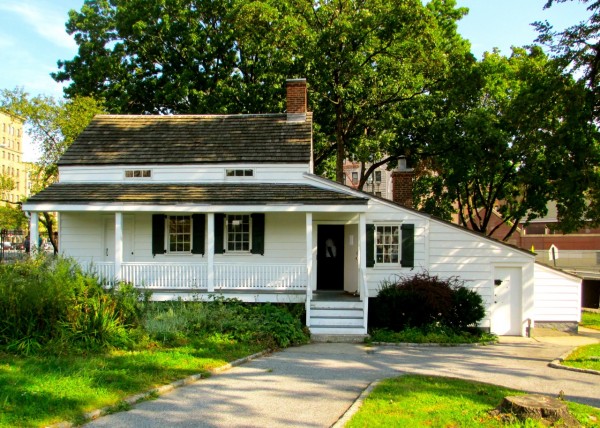
Poe Cottage, i of Edgar Allan Poe's homes in New York. Photo by Jeff Dobbins
Edgar Allan Poe wasn't just a poet and author of macabre masterpieces: He besides was a New Yorker!
Known as America's start groovy lyric poet, Poe is oftentimes associated with Richmond, Virginia and Baltimore. But he moved to New York Metropolis at 22, eager to make his fortune. And the city became the dwelling house of some of his greatest triumphs… and tragedies, likewise.
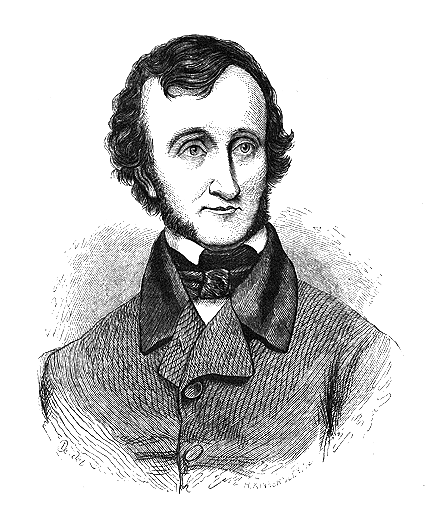
Edgar Allen Poe: poet, horror author… and New Yorker
When Poe arrived in New York in 1831, he had just been dishonorably discharged from West Point University (wanting out, Poe simply refused to attend courses or appear for curl calls). His foster begetter, John Allan, had severed all ties with him.
Destitute, Poe published his Poems: Second Edition with money raised from his fellow cadets. Later 4 months of struggling in poverty, he left New York City for Baltimore.
Poe returned to New York in 1837 seeking piece of work as a magazine editor. This time he was joined by his bride Virginia (she was as well his fourteen-twelvemonth-old cousin!) and his mother in law (and aunt), Maria Clemm.
The trio settled in a Greenwich Village boarding firm at Sixth Avenue and Waverly Place, where they shared a floor with a bookseller.
A few months later, they rented a business firm at 113 ½ Ruddy Street, where Mrs. Clemm gear up a boarding house while Poe continued to write short stories. Neither endeavor produced much income, and the family unit lived in poverty. (During this time, Poe visited the nearby Northern Dispensary, which provided free medical intendance to the urban center's indigent. The triangular building yet stands only east of Sheridan Square).
After a twelvemonth of struggling to survive, the Poes borrowed money to escape to Philadelphia.
After six years in Philadelphia, during which many of Poe's best-known works were published (including The Fall of the House of Usher, The Murders at the Rue Morgue, The Pit and the Pendulum, and The Tell-Tale Eye), Poe returned to New York City in Apr 1844 to make a career as a "magazinist."
"He kept on coming back to New York City because he hoped this was the place to exist for the publishing earth," explains Kathy McAuley, manager of Poe Cottage. "He came back once again and once again, looking for that elusive prosperity."
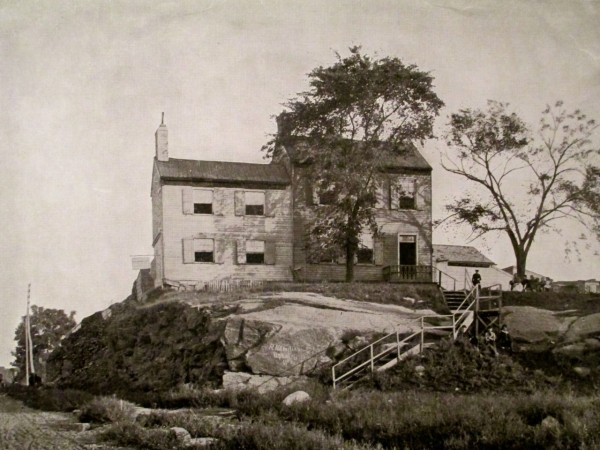
The Brennan Farmhouse in 1879
The trio rented a room at 130 Greenwich Street (i block south of what became the site of the Globe Trade Centre). Later a couple of months in cramped quarters, the family escaped crowded, noisy, and odorous lower Manhattan for the "country": West 84th Street and Broadway. There, they rented two rooms on the 2nd flooring of the Brennan farmhouse, where Poe was apparently quite happy.
"[He was] addicted of rambling down in the forest, between the business firm and the river, and sitting for hours upon a sure stump on the edge of the banking company of the river," wrote Mary Brennan. (That rocky outcrop, which Poe called "Mount Tom," is still in Riverside Park at 83rd Street).
While living there, Poe wrote what is perhaps his most famous work, The Raven. And his room was the inspiration for the chamber in the verse form. Although the firm was demolished in 1888, a plaque stands on the site, and W 84th between Due west End and Broadway has been named "Edgar Allan Poe Street" (although two of the signs misspell "Allan" as "Allen".)
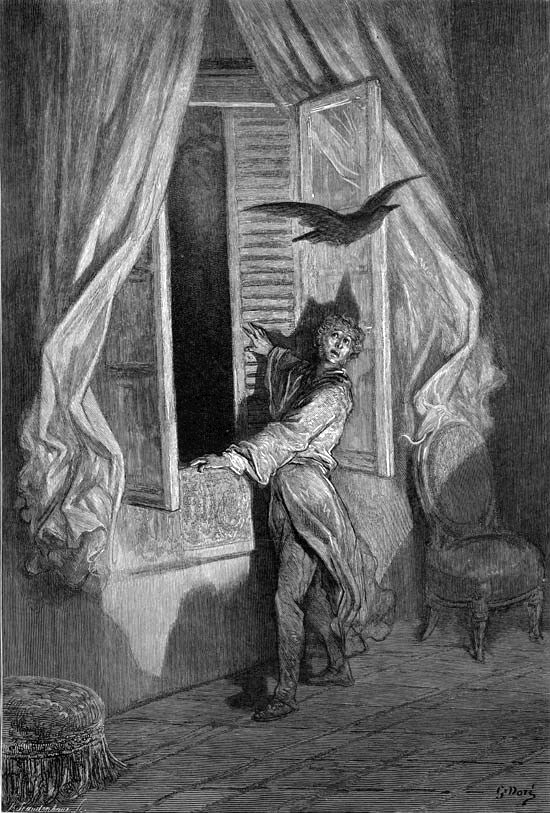
Gustav Dore's analogy for Poe's breakout piece, "The Raven"
In January 1845, The Raven was published in New York, causing a national awareness. Poe became a household name—even though he was just paid $nine for its publication!
It meant, though, that Poe finally was admitted to New York'southward literary lodge. He before long borrowed money from associates to acquire controlling interest in The Broadway Journal. The family moved back to the urban center, living a nomadic beingness with a few months at 154 Greenwich Street, so a boarding house on the Lower East Side at 195 Due east Broadway (now the site of the Educational Alliance).
They finally settled at 85 Amity Street (now called W 3rd Street). While here, Poe revised many of his poetic works, published in his drove The Raven and Other Poems. (In 2000, New York University announced plans to tear downwards the house to create a new building for the NYU Law School. Poe enthusiasts and historical societies protested, causing NYU to reconstruct the 1845 façade on the new structure, preserve an interior staircase, and dedicate a room to Poe, used for readings and lectures).
Unfortunately, Poe'southward good fortune did non last long. In 1846, The Broadway Periodical went bust.
Meanwhile, Virginia'south ongoing tuberculosis worsened. A devoted husband, Poe moved to a cottage in bucolic Fordham Village (now in the Bronx), hoping to amend Virginia'due south precarious health. This was to be their terminal home.
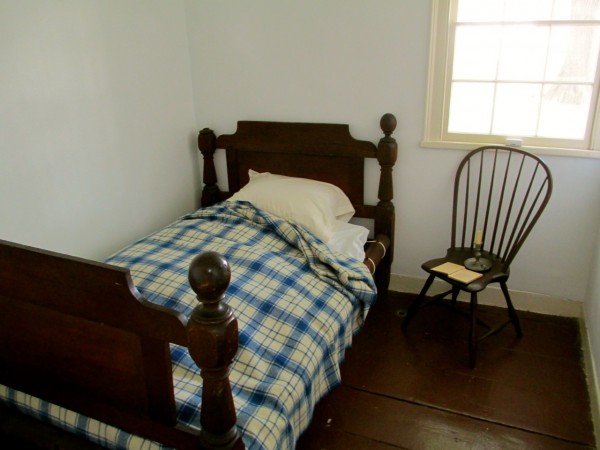
Virginia Poe's deathbed in Poe Cottage. Photo by Jeff Dobbins
Virginia died a painful death in her bed in January 1847. (Y'all can even so visit Poe Cottage,and, yes, even the bed, today; the public museum besides contains Poe's rocking chair and mirror). Grief-stricken, Poe lived in the cottage for ii more than years. Information technology's hither that he wrote The Cask of Amontillado, Eureka, Annabel Lee, and The Bells (referring to the bells that rang from nearby St John'southward College, at present Fordham Academy). He'due south said to have often been seen weeping abreast Virginia's grave in the nearby churchyard.
After a stay in Richmond, Virginia, Poe was plant on a street in Baltimore—delirious, wearing a stranger's clothes, and in need of medical attention. He died in a infirmary on October 7, 1849 under mysterious circumstances. Though there are numerous theories about his cause of death, none tin can exist proven. Poe's death certificate has disappeared.
Though Poe had a circuitous—and not e'er happy—relationship with New York, some say that only as he kept coming back in life… he continues to render in death. His ghost has been seen climbing that original staircase at NYU's Due west 3rd Street Police School.
Poe also is thought to accept lived briefly on the second floor on 47 Bond Street, and enjoyed a drink (or two) in the kickoff floor saloon. The staff at Il Buco Restaurant merits he yet helps himself to the stock in their vino cellar. Thoroughly-sealed bottles are sometimes found half empty.
Want to pay homage to Edgar Allan Poe? In addition to the monuments already noted, there'south PS 46, the Edgar Allan Poe Literacy Development Schoolhouse. There's also a bust of Poe at the Hall of Fame for Great Americans.
Source: https://www.walksofnewyork.com/blog/edgar-allan-poe-in-new-york
Post a Comment for "what happened in fordham new york 1847 to poe"